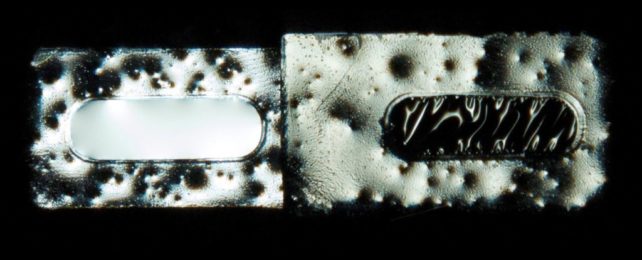Space probes designed to study the Sun are the last places you'd expect to have a moisture problem. Yet a recent investigation has found aluminum filters on two different satellites are degrading as water corrodes their surfaces.
The filters help detect extreme ultraviolet (EUV) emissions, so any kind of clouding is bound to affect their effectiveness. Though the issue has been evident for a while, scientists now finally know what's causing it.
NASA's Solar Dynamics Observatory (SDO, launched in 2010), and NASA and the European Space Agency's Solar and Heliospheric Observatory (SOHO, launched in 1995) both have the same issue. In the first six months, SOHO's Solar EUV Monitor degraded by about 35 percent; in the five years following, it degraded by a further 60 percent.
Solar probes aren't exactly cheap, and neither is launching annual recalibration missions to send new sensors into space. Figuring out why the filters are clouding could see to future solar probe missions being made more robust.
In 2021, a team of scientists led by physicist Charles Tarrio of the National Institute of Standards and Technology (NIST) experimentally figured out what it wasn't – that is, a build-up of carbon causing the fogging, long considered the culprit.
Now they've figured out what it is, and it's surprising: oxidation of the aluminum, caused by the presence of water and induced by ultraviolet radiation. As the layers of oxidized metal build up, the filter becomes foggy, preventing it from admitting the light waves the sensor is designed to monitor.
The surface of aluminum is usually naturally coated with a surface layer of oxide, which occurs when oxygen atoms bond to the atoms on the surface of the aluminum. UV light increases the oxidation rate, causing additional layers of oxide to form.
There's usually not a lot of oxygen in space to bond to the aluminum, but the presence of water, which contains oxygen atoms, could be a game-changer.
To test the water hypothesis, the researchers used the NIST's Synchrotron Ultraviolet Radiation Facility (SURF) to generate EUV radiation, blasting it at an aluminum filter in a vacuum chamber into which water vapor had been introduced.
In their experiments, Tarrio and his team did indeed find a layer of oxide on their aluminum sample that was much thicker than suggested by accepted theory, although not quite as thick as those seen on solar probes. Modeling, however, showed that with sufficient exposure – around 10 months – they would have achieved an oxide layer comparable to aluminum filters on space probes.
Their solution to the mystery, the researchers said, was a "one-two punch."
"Punch one was physically showing that this chemical process involving water could cause something comparable to what we actually see happening in the satellites. And the number two punch is saying once you create a theoretical model that takes everything into account, then the numbers line up quantitatively with what we see in the satellites," explains physicist Robert Berg of NIST.
"Putting everything together, I'm convinced. Water is responsible for the filter degradation."
The next question is where on Earth did the water come from? The team believed that it had to have somehow hitch-hiked a ride on the probes themselves.
"It had to be something that can emit water for five years continuously at reasonably constant rates," Tarrio says. "That set Bobby [Berg] off on this quest to find, what the heck could this be? What could be a source that fits? And he found it."
The answer, to be detailed in an upcoming paper, is the thermal blanket material used to protect the delicate instruments of the probe from extreme temperatures. These are made of layers of a thin sheet of polyethylene terephthalate (PET), coated with reflective metal that reflects most of the heat that hits the material.
However, PET is known for absorbing and holding onto water from the atmosphere. So it goes into space with all this water retention and then, when the solar heat hits it, the water vaporizes and slowly outgasses, releasing into the spacecraft and causing the aluminum EUV filter to oxidize.
"It was hard," Berg says, "to think of anything else that would hold that kind of water."
Everything the Sun does is interesting, but solar flares and coronal mass ejections are of particular interest here on Earth. If they're unleashed in the direction of Earth, the quantities of matter flung towards us can trigger geomagnetic storms that risk interrupting satellite and radio communications, and even interfere with power grids.
This solar matter can take two to six days to reach us, so instruments that can detect their tell-tale waves of EUV radiation ahead of time are crucial for advance warning and predicting the strength of the geomagnetic storm to come.
In future work, the team hopes to explore ways to prevent this oxidization, whether by working on protecting the aluminum, or developing a new filter that can operate in the required wavelength range.
The research has been published in Solar Physics.
